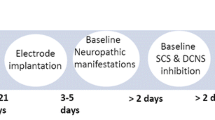Summary
Antibody microprobes were used to measure immunoreactive substance P (irSP) release in the substantia gelatinosa of the lower lumbar spinal cord of barbiturate-anaesthetized cats. Release of irSP was produced by noxious peripheral stimuli. Such release was not altered by blocking spinal conduction at the first lumbar segment by cooling or transecting the spinal cord. The results suggest that the release of irSP from the central terminals of nociceptors is not subject to tonic supraspinal inhibition.
Similar content being viewed by others
References
Barber RP, Vaughn JE, Saito K, McLaughlin BJ, Roberts E (1978) GABA-ergic terminals are presynaptic to primary afferent terminals in the substantia gelatinosa of the rat spinal cord. Brain Res 141: 35–56
Brown AG (1971) Effects of descending impulses on transmission through the spinocervical tract. J Physiol 219: 103–125
Calvillo O (1978) Primary afferent depolarization of C fibres in the spinal cord of the cat. Can J Physiol Pharmacol 56: 154–157
Carstens E, Tulloch I, Zieglgänsberger W, Zimmermann M (1979) Presynaptic excitability changes induced by morphine in single cutaneous afferent C and A fibres. Pflügers Arch Ges Physiol 379: 143–147
Collins JG (1984) Neuronal activity recorded from the spinal dorsal horn of physiologically intact awake drug free restrained cats: a preliminary report. Brain Res 322: 301–304
Duggan AW, Hall JG, Headley PM, Griersmith BT (1977) The effect of naloxone on the excitation of dorsal horn neurones of the cat by noxious and non-noxious cutaneous stimuli. Brain Res 138: 185–189
Duggan AW, Hendry IA (1986) Laminar localization of the sites of release of immunoreactive substance P in the dorsal horn with antibody coated microelectrodes. Neurosci Lett 68: 134–140
Duggan AW, Hendry IA, Green JL, Morton CR, Hutchison WD (1988) The preparation and use of antibody microprobes. J Neurosci Meth (in press)
Duggan AW, Morton CR, Zhao ZQ, Hendry IA (1987) Noxious heating of the skin releases immunoreactive substance P in the substantia gelatinosa of the cat: a study with antibody microprobes. Brain Res 403: 345–349
Duncan D, Morales R (1978) Relative numbers of several types of synaptic connections in the substantia gelatinosa of the cat spinal cord. J Comp Neurol 182: 601–610
Fields HL, Basbaum AI (1978) Brainstem control of spinal paintransmission neurons. Ann Rev Physiol 40: 217–248
Fitzgerald M, Woolf CJ (1981) Effects of cutaneous nerve and intraspinal conditioning on C-fibre afferent terminal excitability in decerebrate spinal rats. J Physiol 318: 25–39
Foong FW, Duggan AW (1986) Brain-stem areas tonically inhibiting dorsal horn neurones: studies with microinjection of the GABA analogue piperidine-4-sulphonic acid. Pain 27: 361–371
Glazer EJ, Basbaum AI (1983) Opioid neurons and pain modulation: an ultrastructural analysis of enkephalin in cat superficial dorsal horn. Neuroscience 10: 357–376
Go VLW, Yaksh TL (1987) Release of substance P from the cat spinal cord. J Physiol 391: 141–167
Hall JG, Duggan AW, Morton CR, Johnson SM (1982) The location of brain stem neurones tonically inhibiting dorsal horn neurones of the cat. Brain Res 244: 215–222
Handwerker HO, Iggo A, Zimmermann M (1975) Segmental and supraspinal actions on dorsal horn neurones responding to noxious and non-noxious skin stimuli. Pain 1: 147–165
Hendry IA, Morton CR, Duggan AW (1988) Analysis of antibody microprobe autoradiographs by computerized image processing. J Neurosci Meth (in press)
Hentall ID, Fields HL (1979) Segmental and descending influences on intraspinal thresholds of single C-fibres. J Neurophysiol 42: 1527–1537
Hunt SL, Kelly JS, Emson PC (1980) The electron microscopic localization of methionine-enkephalin within the superficial layers (I and II) of the spinal cord. Neuroscience 5: 1871–1890
Iversen LL (1986) Chemical signalling in the nervous system. In: Hökfelt T, Fuxe K, Pernow B (eds) Coexistence of neuronal messengers: a new principle in chemical transmission. Prog Brain Res 68: 15–24
Jessell TM, Iversen LL (1977) Opiate analgesics inhibit substance P release from trigeminal nucleus. Nature 268: 549–551
Kuraishi Y, Hirota N, Sato Y, Kaneto S, Satoh M, Takagi H (1985) Noradrenergic inhibition of the release of substance P from the primary afferents in the rabbit spinal dorsal horn. Brain Res 359: 177–182
Lundberg A (1982) Inhibitory control from the brain stem of transmission from primary afferents to motoneurons, primary afferent terminals and ascending pathways. In: Sjölund B, Björklund A (eds) Brain stem control of spinal mechanisms. Elsevier Biomedical Press, North Holland, pp 179–224
Melzack R, Wall PD (1965) Pain mechanisms — a new theory. Science 150: 971–979
Morton CR, Duggan AW, Zhao ZQ (1984) The effects of lesions of medullary midline and lateral reticular areas on inhibition in the dorsal horn produced by periaqueductal grey stimulation in the cat. Brain Res 301: 121–130
Ruda MA, Gobel S (1980) Ultrastructural characterization of axonal endings in the substantia gelatinosa which take up 3H-serotonin. Brain Res 184: 57–84
Schmidt RF (1971) Presynaptic inhibition in the vertebrate nervous system. Rev Physiol 63: 20–101
Uddman R, Edvinsson L, Owman C, Sundler F (1981) Perivascular substance P: occurrence and distribution in mammalian pial vessels. J Cerebral Blood Flow Metab 1: 227–232
Wall PD (1967) The laminar organization of dorsal horn and effects of descending impulses. J Physiol 188: 403–423
Yaksh TL, Jessell TM, Gamse R, Mudge AW, Leeman SF (1980) Intrathecal morphine inhibits substance P release from mammalian spinal cord in vivo. Nature 286: 155–156
Zhu CE, Saudri C, Akert K (1981) Morphological identification of axo-axonic and dendro-dendritic synapses in the rat substantia gelatinosa. Brain Res 230: 25–40
Author information
Authors and Affiliations
Rights and permissions
About this article
Cite this article
Duggan, A.W., Morton, C.R., Hutchison, W.D. et al. Absence of tonic supraspinal control of substance P release in the substantia gelatinosa of the anaesthetized cat. Exp Brain Res 71, 597–602 (1988). https://doi.org/10.1007/BF00248752
Received:
Accepted:
Issue Date:
DOI: https://doi.org/10.1007/BF00248752



